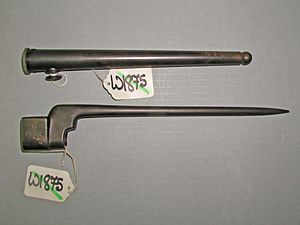No. 4 Bayonet facts for kids
Quick facts for kids No 4 Bayonet |
|
|---|---|

A No 4 mk II Bayonet with its scabbard.
|
|
| Place of origin | United Kingdom |
| Service history | |
| In service | 1941-1954 |
| Used by | United Kingdom |
| Wars | World War II |
| Production history | |
| Variants | No 4 mk I, II, II* and III |
| Specifications | |
| Length | 10 Inches (254 mm) |
| Blade length | 8 Inches (204mm) |
The No. 4 Bayonet was a special knife or spike that soldiers attached to their Lee Enfield No 4 rifles. It was the main bayonet used with these rifles.
Contents
Why the No. 4 Bayonet Was Made
Replacing an Older Design
Before the No. 4 Bayonet, British soldiers used an older design called the Pattern 1907 bayonet. This bayonet was from World War I, and it was time for something new. After World War I, people started looking for a better bayonet. By the start of World War II, they decided that a "spike" type bayonet would be best.
This decision led to the creation of the No. 4 Bayonet. It was designed to be a spike bayonet, which is a simpler, sharper point. Some say its design was inspired by bayonets from Switzerland. The No. 4 Bayonet was officially accepted for use at the same time as the No. 4 rifle.
How the Design Changed During Wartime
During World War II, the design of the No. 4 Bayonet changed several times to make it easier and cheaper to produce.
- No. 4 Mk I: This was the first version. Like many early wartime weapons, it was made with very high quality. Because of this, not many were made.
- No. 4 Mk II: Made in 1942, this was the most common version. It saved time by skipping a step in the blade's production, but it looked mostly the same.
- No. 4 Mk II*: Later in 1942, the design changed again to save money and allow more factories to make them. The blade and the part that attaches to the rifle (the socket) were made separately.
- No. 4 Mk III: This was the final version. It was even cheaper to make because the socket was created by welding together pieces of stamped steel, instead of being made from one solid piece.
Who Made the No. 4 Bayonet
Around 5 million No. 4 Bayonets were made during World War II. Since the bayonet was fairly simple to produce, and government weapons factories were already busy, private companies were asked to help. Many of these companies didn't usually make weapons.
Early Manufacturers
The first company to make the No. 4 Bayonet was a branch of the Singer Manufacturing Company in Clydebank, Scotland. You might know Singer for making Sewing machines! Singer was the only company that made the No. 4 Mk I bayonet, producing about 75,000 of them.
Other companies also made the No. 4 Mk II bayonet. These included:
- The Crown Corporation Small Arms Limited in Long Branch, Canada. This was a Canadian government weapons factory.
- Savage Arms in Chicopee, Massachusetts, United States. Savage Arms also made the No. 4 rifles and provided bayonets to the UK through a program called Lend-Lease.
Each of these three main manufacturers made about a million bayonets. This means the No. 4 Mk II version made up more than half of all No. 4 bayonets produced.
Later UK Production
The later versions, the No. 4 Mk II* and No. 4 Mk III bayonets, were all made in the UK.
- No. 4 Mk II*: Four companies produced this version. Three were in England: Prince-Smith & Stells in Keighley, Yorkshire; Howard & Bullough in Accrington, Lancashire; and Lewisham Engineering in Ladywell, London. One was in Northern Ireland: Baird Manufacturing from Belfast. Prince-Smith & Stells and Howard & Bullough usually made industrial machines. Lewisham Engineering was created just to make these bayonets. About 1.3 million No. 4 Mk II* bayonets were made, with Prince-Smith & Stells making the most.
- No. 4 Mk III: This version was made in smaller numbers by Joseph Lucas Limited in Birmingham. They produced about 200,000 of them. Before the war, Joseph Lucas made parts for cars.

